
ARCHIVED PAGE - PLEASE READ!
This page was written by me a long, long time ago. As such the quality of the writing, photography and/or any conclusions I may have come to simply do not stand up to the levels I consider necessary these days.
I do not believe in deleting things outright though as I feel that these pages form something of a time capsule from an earlier stage in my life, and may still be of some interest to folks who have been coming here for a long time. So instead of deleting this page it has been archived.
PLEASE NOTE THAT THIS PAGE HAS BEEN ARCHIVED, AND SHOULD BE CONSIDERED "FOR INTEREST ONLY" AND NOT BE USED FOR ANY OTHER PURPOSE. LINKS, PRICING ETC ARE LIKELY TO BE OUTDATED AND WILL NOT BE UPDATED.
Heliotek HTE-1 (Revision 2). Rating: 94%

The HTE-1 is the debut product from Heliotek, having just been released in its second version. It's a light primarily designed to replace the clunky outdated 2D style lights in use by police officers and people in similar roles. Despite its ordinary appearance, this is a light that's designed to keep working when almost anything else won't. It features a formidable array of features, which should certainly be enough to make competitors take note; these include the use of both stainless steel and GE Lexan for the body, a completely sealed head assembly (even including the switch), a very efficient regulator circuit - more on that later - a removable tip-off beam shaper, and a very, very well designed reflector.
This light is the definition of a high-end lighting device. It's been designed with functionality and reliability in mind the whole way through.
...and like nearly all black flashlights, it simply DEFIES being photographed properly!
The introduction aside, let's get on with the review itself.
Product Info:
Manufacturer: Heliotek.
Available from: N/A - Obsolete Product.
Price (Correct as of April 2005): $99.95US (Approx £55).
Number of lamps: 1.
Lamp Type: 1.2W Luxeon Star LED (High Dome).
Lamp Current: 325-340mA.
Lamp Colour: White (V1 or W0 Bin).
Body finishes available: Black. GE Lexan Resin and Sanoprene rubber.
Battery type: 2 AA Lithium (Energizer E2 recommended). (Supplied).
Switch Type: 4 way slider. Momentary and constant. No lockout mode.
Water Resistance: Fully waterproof (Depth tested to 150 feet).
Approximate Beam angle: ~2 Degrees (without diffuser).
Notes: Light comes supplied with 4 Energizer E2 lithium cells, belt holster, Ziploc bags for storage of spare cells, detachable and adjustable breakaway lanyard, detachable flip-up beam diffuser, instruction manual and a pocket clip.
Beam profile without diffuser (from approx 1 metre).
![]()
Beam profile with diffuser (from approx 1 metre).
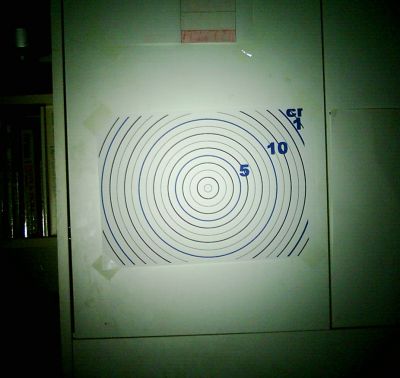
The camera totally murdered the colour in the beamshots on this page - the beam is actually a pure, snow-white colour. The yellow-green tint is NOT there. No amount of fighting with my cameras settings however made it look right...sorry!
Packing:
The packaging of the HTE-1 reflects the fact that the light isn't primarily aimed at the retail market. The light and its accessories are supplied in a simple cardboard box, with cut outs to accommodate the light and the Energizer E2 lithium batteries. The batteries are actually supplied in two little Ziploc bags however, rather than in the holes for them - granted, mine had been shipped half way around the world, so this may not always be the case. Simple it may be, but the packaging survived its multi thousand mile journey totally unscathed.
This type of packaging does have one major advantage over a lot of other types - that you don't need to contact the army to get into it! Just cut the tape holding it closed along the seams and lift the lid, then you can start playing...er...I mean testing, yes, that's what I was saying, your new light.

Power Source:
The HTE-1 is powered by two AA size batteries, and specific instructions are given to use only lithium ones - specifically Energizer E2 Lithiums. While a little pricey, these cells do work very, very well with the light.
The HTE-1 has one of the most effective regulators I have seen, providing almost rock steady output for 7-8 hours before dropping to very low levels for a very long time afterward. I really cannot emphasise enough how flat the discharge curve from this light is. I do not presently have the equipment to produce output graphs, but I hope to change that soon. When I do, there will be a graph here.
This is a very impressive runtime for a 2AA light, but despite that, the batteries will eventually need to be changed - not to mention installed first time around. This is simple.
1. Holding the light so that the head is facing away from you turn the head slowly clockwise - do this slowly to release any gas which may have built up inside the light from the batteries from extended use - a slight build up is normal, and shouldn't be worried about. It is simply due to the light being totally sealed.
2. Tip out the old batteries if there are any in there, and insert two new ones, negative end toward the tailcap.
3. Then all that remains is to screw the head back onto the body. This should be reasonably firmly tightened to ensure there is a good contact between the O-ring on the battery tube and the head - but be careful not to tighten it too much. The threads on the battery tube are stainless steel, and those in the head are plastic (albeit very strong plastic!), and theoretically, you could strip them. I don't see it ever happening in normal use, but use common sense.
You may find yourself wondering why Heliotek specifically state that the somewhat expensive E2 lithium batteries must be used.
1. The most obvious one. The lithium cells have a greater energy density than normal alkaline ones, and a flatter discharge curve. This allows the current regulator in the light to provide that lovely flat discharge curve, and the 7 hour runtime.
2. The lithium cells are far less likely to leak, causing damage to the light internally.
3. The lighter weight of the lithiums allows the light to float. It would sink if alkalines were used.
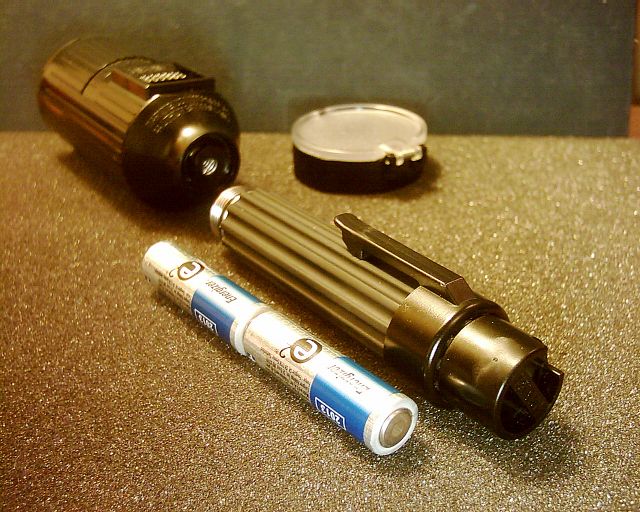
Another flashlight reviewer tested the light using alkalines, and it did indeed work correctly. The runtime however was significantly shorter, just under two hours, and the discharge curve was not quite so flat. Using alkalines in the light will void the manufacturers warranty, but it's nice to know that in an emergency if you can't find any more E2's, that you can use normal AA cells if necessary.
Heliotek are kind enough to provide not just one, but two sets of batteries with the light, supplied in little Ziploc bags. There is also a small pouch on the holster to allow you to carry a spare set with the light at all times.
Very long battery life and some of the best regulation around. Shame the cells are so expensive though.
Lamps:
The light source used in the HTE-1 has actually been around for a few years now. LumiLED's Luxeon I emitter. Rated at 1.2W, this is still a strong performer. The Lux1 cannot produce as much light as its big 3 and 5W brothers, but in this case it works out as a very good balance between output and runtime. The 5W version has a far greater light emitting area, so focusing it into a tight spotlight as seen here would require a very, very big reflector.
The light source in the HTE-1, being LED based, is basically impervious to vibration or shock damage, and has a very, very long lifetime (>50'000 hours), making the light a very safe bet in just about any conditions. The light is covered by a 10 year warranty, and I very much doubt the LED will burn out before then!
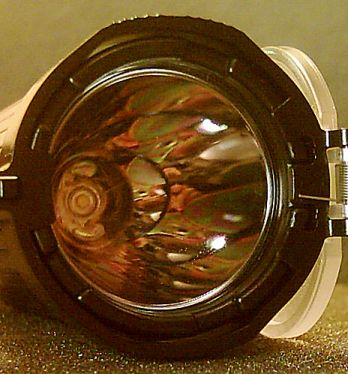
The reflector in the HTE-1 is a very impressive piece of optical design. The thing about designing a reflector for an LED, is that the light is being emitted from a more or less flat surface, rather than in a 360° radial pattern as from an incandescent filament. This means that to get a very tight beam, the reflector design has to be a little different to that you see in incandescent lights. As a result, the HTE-1 features what has to be the deepest profile reflector I have ever seen. The pictures really do not show it well, it is very, very deep. It is also of a very, very high quality, highly reflective, with no visible imperfections visible on the surface of my example at all.
Heliotek really did their homework before producing this combination of light source and reflector.
Operation:
The HTE-1 is a simple light to use. This is at least partly due to the fact that it's very similar initially to the old slide switch lights which everyone has used. Slide the switch forward for light, back for non-light. This switch however has a couple of tricks up its sleeve...er...okay, it doesn't have sleeves, so I'm not sure where it's hidden the tricks. You get the idea though! It's a clever design.

Heliotek have managed what has long seemed impossible - they have successfully combined a momentary and constant mode switch into one unit, which is easy to work out, and can easily be operated in BOTH modes with one hand.
Though not maybe apparent on initial inspection, that switch has not two, but four operating positions. On and off in both modes. With the light held so that it's facing away from you, the switch will operate in momentary mode when slid to the left, slide forward to light, release to extinguish the light. If however, you click the little slider to the right, the light will then operate in constant mode, the switch latching in the on position. The switch can quite happily switch from momentary mode to constant mode and back again regardless of whether the light is switched on or not.
In case you get confused, there are actually arrows on the switch to tell you which way to push the switch for both modes, and a little legend reading "0 OFF" and "1 ON" to tell you whether the light's on or off - though it's bright enough that you'll usually know!
Also, they have managed to address the one complaint that several people had about the original HTE-1: that while the almost laser-like spotlight beam is all very well, there are times that side spill is needed. However, they managed to do this without actually needing to mess around with their wonderful optical system itself. This was accomplished by the use of a "tip-off" type diffuser which clips in place over the lens. This type of assembly is often used on military lights I believe for holding in place IR/coloured filters, but works quite nicely on the HTE-1 for holding its beam shaper as well, thank you very much.
To flip the diffuser out of the way, simply grasp the head of the light so that the switch is facing the palm of your hand, and placing your thumb and forefinger on the rim of the light, squeeze firmly on the two ridged parts. It does require a fair squeeze to get it to pop off, but mine does seem to have become a little more user-friendly after a few tens of uses, we'll see how that goes. If you require to remove it entirely, simply squeeze firmly in the same place again, and pull it off - it's a pretty tight fit, and is held in place by a couple of "teeth" which locate on the HTE-1's head, so you might need to wiggle it around a little - it's more apparent what I mean when you actually have the light in your hands. Refitting is simply the reverse of removal. It's a little fiddly getting the aforementioned teeth to actually slot back into their holes, but this is helped by the fact that there is a notch underneath the spring of the diffuser, this slots into a visible groove on the head of the light, allowing things to be lined up properly. Un-flipping the diffuser is totally self-explanatory - just swing it back round and click it back into place.
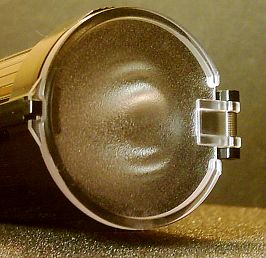
The pocket clip attached to the battery compartment is also removable if you wish to. This is accomplished simply by removing the head (as for a battery change) and sliding it up and off. It is worth nothing though, that it is a VERY tight fit on the barrel, and I actually had to place the barrel on the desk and lean down on the pocket clip to get it to move. Rotating it doesn't help either as it's keyed into the grooves in the Sanoprene cover on the barrel. I did eventually get it off though, though it did leave three circular dents in my desktop! You may want to try lubricating it with some washing up liquid or maybe even just water beforehand, though that might just make your hands slippery too. Ah well, time for some more experiments I think...
The attached lanyard can also be removed if you wish, this is quite simple. Firstly, remove it from the breakaway point (the Velcro thing), as that stops the rest of it getting in the way. The push the lanyard into the tailcap a little, this should cause the "loop" inside the tailcap to lift up enough to get a hold of - if not give it a poke with something like the clip of a Bic pen lid or something. Withdraw the little stainless steel pin which the lanyard loops around and put it somewhere safe (like one of the supplied Ziploc bags for instance), and withdraw the rest of the lanyard. Replacement is the exact opposite of removal.
Nothing complicated there, really. The diffuser removal instructions sound more in depth than they really are.
Ergonomics:
Despite its large head and narrow body, the HTE-1 actually feels really nice in the hand. The lightweight batteries help this I guess, as the balance point is actually right at the junction between the head and body. As a result, the light feels very nicely balanced, nowhere near as head-heavy as it looks. The barrel is also a very nice diameter, and when holding the light in the "conventional" manner, your thumb lands perfectly on the switch. Due to the larger diameter of the head and excellent balance, it is also possible to use the light quite comfortably in a slightly modified tactical grip, an honour not usually achieved by lights this shape using slide switches!

The switch itself works really very well. The momentary action is nicely weighted and silent, while changing modes and switching on/off requires a sensible amount of force, and is accompanied by a nice solid tactile "click." The switch slider has quite an aggressive diamond knurled texture on it, helping your finger/thumb to operate it if your hands are wet, oily or gloved.
The battery compartment is covered in Sanoprene rubber, this is a very, very tough thermoplastic compound, and has a nice rubbery, grippy feel to it. The ridges also help you keep a grip with wet or oily hands. There are also ridges moulded into the head itself, but most of the grip is provided by the body itself rather than the head.
The tailcap has been nicely designed as well, allowing both the attachment of a lanyard, while retaining the ability to stand on end to illuminate a room. The light is actually surprisingly stable standing like that, given the size. The tailcap has another trick in store for you, in that it can rotate independently of the body. No more tangled up lanyards!
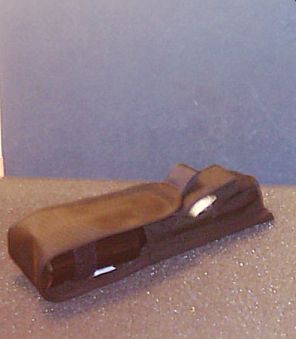
Generally, I am unimpressed with the holsters supplied with lights; they usually seem to be little more than a vaguely flashlight shaped nylon bag with a little flap on the top thrown into the box for good measure, and allowing something to be added to the features list. Not this one. The holster supplied with the HTE-1 is very well designed indeed, custom shaped to the unique shape of the HTE-1, and made from what feels like a good sturdy nylon material. There is a little pouch on the front of the holster for storing spare batteries (though this is a bit of a tight fit), and a Velcro strap to hold the head in position in the holster. The method of holding the main flap down is somewhat unusual too, it's technically like Velcro...but not. It consists of two bits of plastic type material with what another reviewer very accurately described as "a forest of tiny mushrooms" on, these lock together nice and firmly though, requiring to be squeezed together though, this I count as a good thing, given traditional Velcro's tendency to stick to anything and everything it comes into contact with! The battery pouch uses conventional Velcro though.
I can really only think of one non-positive comment about the ergonomics of this light, and that comes back to the pocket clip. I found that it tended to get in the way when fitted - not to the point of being a real pain - just that I find the light a lot more comfortable to use with it removed.
Overall a very, very well thought out light in every way, it's nicer to use than it looks like it should be - it was designed to be used.
Performance:
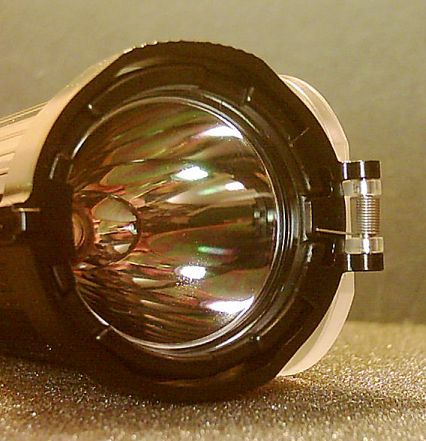
So far, the HTE-1 seems to be doing inordinately well, doesn't it. So we'd expect it to fall short here then, wouldn't we. Just on principle...it can't be so well thought out AND perform well, can it? Erm...yes, it can actually. Very well in fact.
This is all down to that regulator and reflector again. The Luxeon star used here is a pretty average performer these days, there are lights out there using far more powerful 3 and 5W Luxeons, but those lights don't have the HTE-1's reflector, do they?
I honestly can not think of another 1W LED light which can throw like this can. In fact, I can't think of another light which throws like this one which you can stuff in your pocket. The Nuwai ALX-113AA held the record as my longest throwing LED light for a long time, but this thing just melted a hole right through that record. It totally knocks the socks off incandescent lights the same size - and considerably bigger in a lot of cases. I did a little test at a friend's place, and the HTE-1 does indeed consistently out throw a common aluminium bodied 2D cell incandescent flashlight - and you can carry this around without feeling that you're carrying a small family car in your pocket or on your belt.
Clipping the diffuser in place however, you discover the other side of the HTE-1's character; that the diffuser broadens the beam into a medium flood, perfectly smooth and more than bright enough for pretty much any task you're likely to throw at it. Excellent for walking around inside and outside the house, yet still with the option to instantly pop off the diffuser to get a look at something further away if needed. Using the 2D in flood mode introduces lots of nasty rings and swirls, and getting back to spot mode entails messing around with focusing - by the time it's there, I can have had the HTE-1 there and back to flood again.
The fact that the HTE-1 retains this brightness right until the batteries are totally dead works very well for it too. It doesn't dim out over time, and the beam colour remains completely constant. I also failed totally in trying to make the HTE-1 flicker by shaking it or subjecting it to vibration (tied to bicycle handlebars - makes a very effective bike-light too if you can figure out some way to mount it).
Illuminating my workstation from approximately 5 metres without diffuser in place.
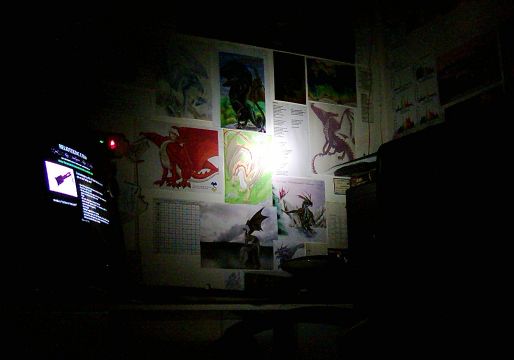
Illuminating my workstation from approximately 5 metres with diffuser in place.
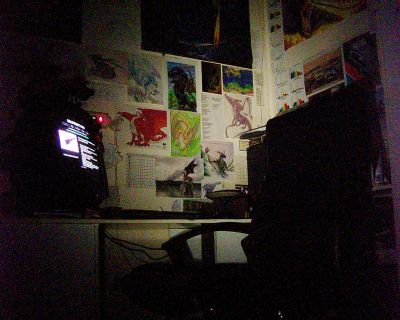

Like all high quality instruments, the HTE-1 has a serial number, this is stamped on the head directly opposite the switch.
Durability Department:
This light is one tough cookie, there's no doubt whatsoever about that. It shrugged off the usual throw, drop and drowning tests with sheer impunity. At least one other flashlight reviewer has run a Revision 1 HTE-1 over with a 400 pound electric wheelchair with no ill effects. Like I said - this is one tough cookie!
Not having a replacement on hand, I'll forgo putting the HTE-1 through the horrors of being run over by a car, as I doubt that - tough though that Lexan head is - it would survive that. That test is one best left to the very heavy duty all-metal lights.
There are few weak points in the design that I can see, well, I can't actually see any that leap out to my attention. The only thing I can see getting broken if abused is the diffuser, and having given it an experimental tug or two, it actually seems surprisingly strong - I wonder if that too has been made of Lexan? Will make sure to ask, and report back here.
The lens, like the rest of the head assembly is Lexan, and also has a silicon coating to help improve its resistance to scratches (that can be seen in the photographs of the reflector - it imparts a very slight green tint to reflections from the lens itself). The lens however cannot be replaced, so don't go out of your way to get it scratched - keeping the diffuser attached to the light and clipped closed when not in use should protect it to a large extent though. I do not know if replacement diffusers are available from Heliotek or not, but I shall find out. Even if the diffuser did get scratched up though, it should not affect its operation to any real extent, other than maybe widening the beam still further.
Water resistance is very, very good. Heliotek test each and every light to a depth in excess of 150 feet (to which the light is rated). This is almost unheard of for lights featuring a slide switch - this is down to how that switch works. The bit of the switch you see and work with does not actually penetrate the body of the light at all. That slider simply moves a small magnet around, this operates a reed switch inside the light body, eliminating the need for holes through the otherwise watertight head. I'm sure if they could have thought of some way to change the batteries without having to dismantle the light, they would have! To maintain this depth rating, it's important to lubricate the O-ring on the battery tube periodically, silicone grease is suitable for this purpose. The light should also be rinsed off with fresh water if it has been used in salt water, especially the switch, or you could get nasty crusty deposits in there.
Due to the use of a magnet in the HTE-1's switching system, it's worth noting that the light should not be stored close to strong magnetic fields, i.e. large speakers, the hard drive magnet you stuck to the radiator last year and haven't managed to get off yet, or that pole transformer you've got powering a Jacob's Ladder in the corner...these are the obvious ones. However, one you may *not* have thought of; the television set, the degauss coil may have sufficient punch on a big set to cause the magnet problems - so just keep the HTE-1 a sensible distance away from the set on powering up. I very much doubt this would cause any problems - it's just something I thought may be worth mentioning. I have tried to torture the light magnetically without any adverse effects. Some powerful neodymium magnets managed to switch the light on when brought near enough to it - but didn't leave any lasting effects. I'm not going to recommend that you do this to your poor HTE-1 though - I do these things so you don't have to!
Heliotek are obviously confident in their product as well, as it comes with a 10 year warranty.
Overall, this is about as tough as they come. Try to break it, and you'll probably break yourself first.
Overall:
As you can probably tell from the review above, I really, really like this light. It is completely capable of replacing any and every flashlight for day-to-day tasks, which is basically what Heliotek set out with the intention to make! The original HTE-1 was a great light, and achieved astonishingly good reviews from many well known reviewers. Then what did they do? They went and made it even better with this version!
The HTE-1 is darn near indestructible, runs for a long time on batteries, and is as easy to use as they get. It's really nice to see that someone has finally managed to combine momentary and constant mode switches in one unit which actually can be used one handed. I've been waiting a long time to see that.
The only downside for the HTE-1 really is the price. It isn't a cheap light, at nearly $100, it's enough to put off a lot of the general public, who still think that a MiniMag is the last word in personal lighting. That and the appearance. To be honest, the look of the HTE-1 appeals to me. It just *looks* purposeful and well engineered, but a lot of people seem to think it looks cheap and ugly. It is not a fashion item anyway, this is a high quality tool, designed to be used. And everyone who's criticised it so far has instantly changed their opinion once I let them use it!
Overall, a very, very good light indeed. If you can afford one, go buy one, go do it right now. You will not be disappointed.
Pros:
+Throws like nothing else its size.
+No bulbs to burn out.
+Excellent battery life and regulation.
+Easy to use.
+The switch is a work of sheer genius.
+VERY Durable.
+Very good beam colour.
+Excellent water resistance.
+Integral but removable beam diffuser.
+Feels great in the hand.
+Excellently designed holster.
+10 year warranty.
+Can be stood on end to illuminate a room AND has a lanyard.
Cons:
-Batteries may be hard or expensive to find in an emergency.
Niggles:
>Diffuser can be a bit hard to flip off, needs to be though to stop it getting removed accidentally.
>If the diffuser is flipped up, the light is unstable when stood face down. Removing or closing the diffuser rectifies this though.
>Is a little on the long side to put in a pocket - but that's what the holster's for.
>Some people might not like the appearance - but this is a tool NOT a fashion accessory.
Ratings:
Beam Quality: 10
Build Quality: 10
Battery Life: 9 (highest non rechargeable lights can get!)
Durability: 10
Value: 8
Overall: 47/ 50 = 94%
Many thanks to Bill of Heliotek for sending me this sample for review! Kudos to them, they're the first company ever to do that for me!
Long Term Testing:
15th April 2005. Uploaded images only. Review to follow.
24th April 2005. Completed bulk of review. Have a couple of queries for Heliotek, and I NEED to re-shoot those beam photos. Here's most of the review though.
8th May 2005: And before I even had time to get the email off to Bill at Heliotek - one dropped into my inbox answering the questions. Now that's service! So, straight from the email, here's the extra data:
1) Lamp Current: Unknown. Heliotek's HTE-1 circuitry holds the current between 325 and 340 milliamps. We meet all of the Lumileds requirements for the Luxeon I as to current and die temperature from -40C to 45C.
2) Lamp Colour: White The HTE-1 uses only selected Luxeon color bins V1 or W0.
3) The HTE-1 has one of the most effective regulators I have seen, The HTE-1 regulator circuitry runs at 89-95% efficiency and it actually costs more than the binned Luxeons.
4) You may find yourself wondering why Heliotek specifically state that the somewhat expensive E2 lithium batteries must be used. The fact that really drove the HTE-1 design is: The Energizer L91 has the highest energy density for a unregulated shipment (by the UN) high current discharge Lithium: 300milliwatt-hours per gram. This is a little known fact.
5) Shame the cells are so expensive though. True, though this works out in the US @ a cost of $2/batt, to less than $0.01/minute which with a shelf life of 8-12yrs (colder ambient=longer shelf) and 6-8hrs run (higher temperature=longer run) and light weight and -40C to 45C operating temperature isn't too shabby if you need to depend on a light.
5) ...and is accompanied by a nice solid tactile "click." The HTE-1 accomplishes this using a micro stainless steel spring loaded detent which doesn't come cheap. It 's little details like this that have run up the selling price.
6) ...and made from what feels like a good sturdy nylon material. The HTE-1 holster is made from 1090 denier ballistic nylon. This was used in flak jackets prior to Kevlar and M5.
7) Like all high quality instruments, the HTE-1 has a serial number, this is stamped on the head directly opposite the switch (at least I think it is! I really should check before posting this page!) You have this dead on.
8) ...the diffuser, and having given it an experimental tug or two, it actually seems surprisingly strong - I wonder if that too has been made of Lexan? Once again you've got it right! Lexan all the way.
9) I do not know if replacement diffusers are available from Heliotek or not, but I shall find out. Yes, they are, should you need one.
Page change log:
3rd August 2009: Sorted out the dodgy page formatting (sorry it's taken me since December 08!). The HTE-1 is still working like new, and is still one of my most used lights.
5th January 2021: Page retired and moved to Site Archive.
28th April 2023: Revised Statcounter code to allow for HTTPS operation.
3rd October 2023: Manufacturer's website no longer exists - Link has been removed.